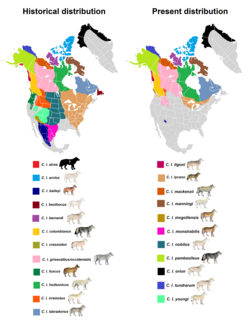| Mackenzie River wolf | |
|---|---|
 | |
| Scientific classification | |
| Domain: | Eukaryota |
| Kingdom: | Animalia |
| Phylum: | Chordata |
| Class: | Mammalia |
| Order: | Carnivora |
| Family: | Canidae |
| Genus: | Canis |
| Species: | |
| Subspecies: | C. l. mackenzii |
| Trinomial name | |
| Canis lupus mackenzii | |
 | |
| Historical and present range of gray wolf subspecies in North America | |
| Synonyms | |
Canis albus mackenzii | |
The Mackenzie River wolf or Mackenzie Arctic Wolf (Canis lupus mackenzii) is a subspecies of gray wolf which is found in Canada's southern portion of Northwest Territories. Not much has been published on Canis lupus mackenzii but one of the most comprehensive studies was done in 1954 by W.A. Fuller, Wolf Control Operations, Southern Mackenzie District, Canada Wildlife Service Report.[ citation needed ] This wolf is recognized as a subspecies of Canis lupus in the taxonomic authority Mammal Species of the World (2005). [4]
This wolf subspecies can be found in Tuktut Nogait National Park. [5]
